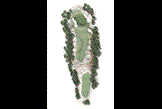Why playing Pinehurst will be hell
Published:
The wire grass
“The wire grass that lies alongside our fairways introduces an unknown that a lot of the players are not going to like,” believes Bob Farren. “At most US Opens, they know that if they miss the fairway, they are going to be hacking out of three or four-inch rough. Here, when their ball runs off the fairway, they could get a perfect lie or they could find themselves nestled in a footprint or against some wire grass. I can’t imagine people playing 72 holes and not having to take a drop or chop out sideways at least once or twice. So I think the players who will rise to the top of the leaderboard will be the ones who can stay patient, take their medicine and appreciate that bad lies are going to happen to everybody.”
Its greens are a nightmare
“Augusta and Pinehurst are probably the two toughest sets of greens that I know,” says Nicklaus. “Of the two, I think Pinehurst’s are tougher, because of the sharp edges and run-off areas.”
“Pinehurst’s greens are probably the smallest greens we play in any US Open,” says two-time US Open champion Retief Goosen. “Size-wise they might look like they’re reasonably big, but they’re definitely some of the smallest and most difficult greens to hit from any distance.”
Worse still: “It’s not good enough to simply hit the green,” says Farren. “To succeed here, you have to right part of the green. For example, if you are at the back of the 13th green putting towards a front hole location, it’s very difficult to keep the ball on the green.”
The par 3s are tough
On a lot of courses, the par 3s offer some respite. Not on Pinehurst No.2… “The par 3s are really tough,” says Kelly Mitchum. “If you make three on all of them, you will make up plenty of ground on the field.”
“The par-3 6th is very penalising if you miss to the left or right, because the bunkers are deep,” says John Patota. “The green is really tough too. It may look pretty big, but it slopes so severely that only about half of it is playable.”
“If there is a front hole location on the 6th, it’s very difficult to keep putts from the back of the green on the putting surface,” adds Bob Farren.
Birdies will be few and far between
“You don’t hear many roars at Pinehurst,” says Tiger Woods. “But that’s the nature of this course. At Augusta, you hear eagle roars and you hear big putts being made. But who is going to hole out from off the side of one of these greens? Out here, guys are just trying to make pars.”
“It’s really difficult to shoot low scores on the No.2,” admits Kelly Mitchum. “I have shot a 66 in practice, but my best round in a tournament is 69. It’s just not possible to make six, seven or eight birdies round here, because there are no easy birdie holes.”
Miss in the wrong place and you’re dead
“Because of the severe difficulty around the greens, the key to No.2 is taking big numbers out of play by missing in places where you have a chance to get up and down,” reveals Kelly Mitchum. “If you don’t do this, then you’re going to find yourself in a position where you have to hit the shot perfectly in order to keep it on the putting surface. A good example of this is the 8th. Anything left of that green falls off and leaves you with a chip or putt that has a good chance of coming right back to your feet. John Daly (left) found himself down here during the 1999 US Open. After a few attempts, he was so frustrated that he incurred a two-shot penalty for hitting the ball when it was rolling back down to him. He eventually walked off with an 11 on the card.”



